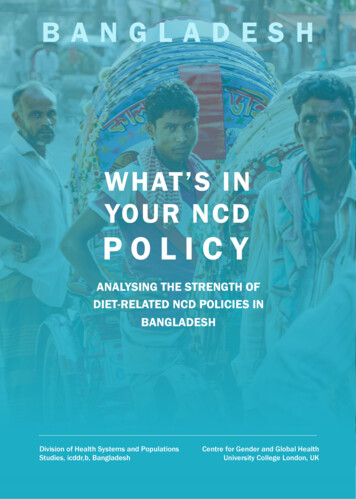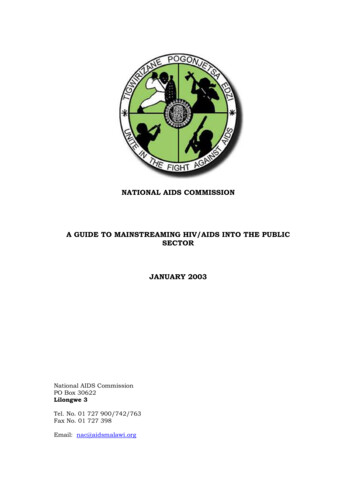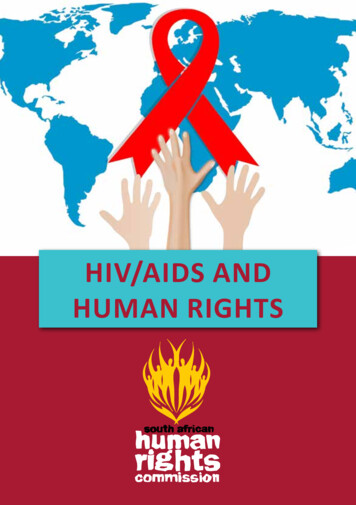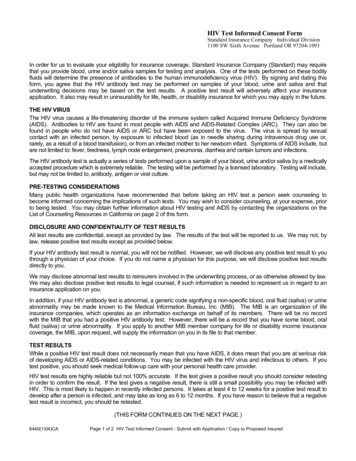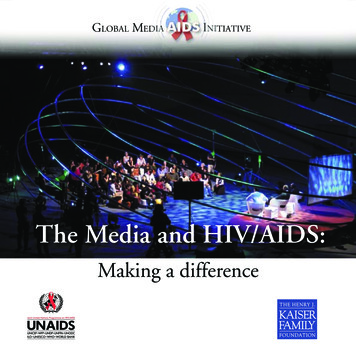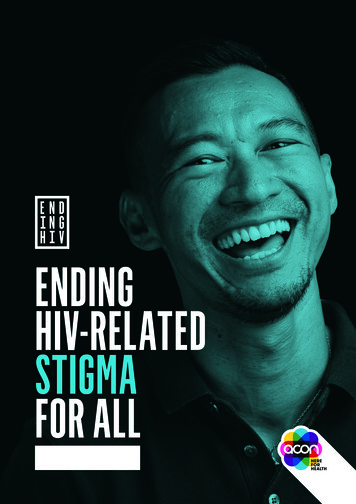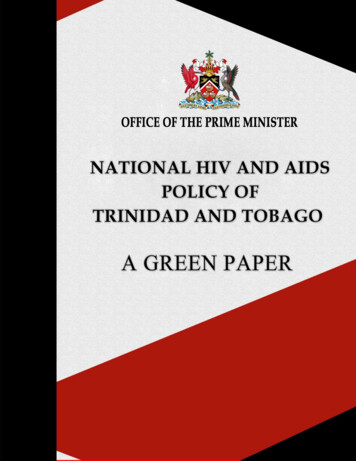
Transcription
NATIONAL HIV AND AIDS POLICY OF TRINIDAD AND TOBAGO - A GREEN PAPERTABLE OF CONTENTSEXECUTIVE SUMMARY . 61INTRODUCTION . 82BACKGROUND . 82.1Methodology . 92.2The National Policy Environment . 92.2.1The National Development Strategy . 102.2.2The National Strategic Plan for HIV and AIDS 2013-2018 . 102.2.3Legislative Context . 122.3International Commitments and Protocols . 132.4Situation Analysis . 162.4.1Epidemiology of HIV and AIDS in Trinidad and Tobago . 162.4.2Social, Behavioural, Structural Drivers of the HIV Epidemic . 212.52.5.13The National Response . 24Achievements and Challenges . 28POLICY FRAMEWORK . 323.1Conceptual Framework . 323.2Scope . 323.3Vision and Mission . 333.4Underlying Principles . 333.5Policy Goals . 353.6Policy Objectives . 353.7Policy Outcomes. 364POLICY STATEMENTS . 375PRIORITY AREA 1: PREVENTION . 375.1Rationale . 375.2Strategic Objectives . 375.3Policy Statements . 385.3.1Combination Prevention . 385.3.2HIV Testing, Counselling and Linkage . 395.3.3Condoms and Lubricants . 415.3.4Prevention of Mother to Child Transmission . 425.3.5Post Exposure Prophylaxis (PEP) . 431
NATIONAL HIV AND AIDS POLICY OF TRINIDAD AND TOBAGO - A GREEN PAPER65.3.6Pre Exposure Prophylaxis (PrEP). 435.3.7STI Management . 435.3.8Information, Education and Communication . 445.3.9Behavioural Interventions . 455.3.10Behaviour Change Communication . 465.3.11Use of Technology and Other Creative Methods in Prevention Efforts . 46PRIORITY AREA 2: TREATMENT, CARE AND SUPPORT . 486.1Rationale . 486.2Strategic Objectives . 486.3Policy Statements . 496.3.1A Treat All Approach . 496.3.2Service Delivery . 496.3.3Client Centred Models of Care . 506.3.4Anti-Retroviral Therapy and Adherence . 506.3.5Treatment of Co-Infections. 516.3.6Treatment Monitoring . 526.3.7Health Systems Support . 526.3.8Sexual and Reproductive Health . 536.3.9Psychosocial Support . 536.3.10Nutrition and Food Security . 546.3.11Laboratory Services . 556.3.12Access to Treatment and Care Services During and After HumanitarianEmergencies and Crises . 557 PROMOTION OF HUMAN RIGHTS AND CREATION OF AN ENABLING AND EMPOWERINGENVIRONMENT FOR PLHIV, KEY POPULATIONS, VULNERABLE GROUPS AND COMMUNITIES ANDMITIGATION OF THE IMPACT OF HIV AND AIDS . 577.1Rationale . 577.2Strategic Objectives . 587.3Policy Statements . 587.3.1Enabling Legislative Framework . 587.3.2Redress System for Reporting Abuses and Discrimination Against PLHIVS and KPs. 597.3.3Gender Sensitivity . 597.3.4 Protection, Empowerment and Participation of PLHIV, Key and VulnerablePopulations . 602
NATIONAL HIV AND AIDS POLICY OF TRINIDAD AND TOBAGO - A GREEN PAPER897.3.5Women, Girls and HIV . 617.3.6Mitigating the Impact of HIV on PLHIV . 617.3.7Confidentiality . 627.3.8Partner Notification and Referral . 627.3.9Migrants . 627.3.10Prison and Detention Settings . 637.3.11Gillick Competency . 637.3.12Community and Civil Society Strengthening . 637.3.13Workplace Settings . 64STRATEGIC INFORMATION AND KNOWLEDGE MANAGEMENT . 658.1Rationale . 658.2Strategic Objectives . 658.3Policy Statements . 668.3.1Resources for Effective and Sustainable Strategic Information . 668.3.2Monitoring and Evaluation . 668.3.3Research . 668.3.4Surveillance . 678.3.5Data Management System . 678.3.6Data Use and Disseminaton . 68COORDINATION, IMPLEMENTATION AND MONITORING . 689.1Rationale . 689.2Roles and Responsibilities of Implementing Partners . 699.3Leadership and Knowledge Management . 789.4Resourcing the National Response . 789.5Monitoring and Evaluation of the Policy . 79APPENDICES . 80APPENDIX I-NATIONAL POLICIES AND PLANS RELEVANT TO HIV AND AIDS . 80APPENDIX II- LISTING OF LEGISLATION RELEVANT TO HIV AND AIDS . 83APPENDIX III – GLOSSARY . 85REFERENCES . 913
NATIONAL HIV AND AIDS POLICY OF TRINIDAD AND TOBAGO - A GREEN PAPERLIST OF TABLESTable 1: International and Regional CommitmentsTable 2: Ratified International AgreementsTable 3: Reported new HIV Infections by Age and Sex, 2005-2017Table 4: Key Achievements and Challenges by Priority AreaLIST OF BOXESBox 1: Other Key MilestonesLIST OF FIGURESFigure 1: Priority Areas of the National Strategic Plan for HIV and AIDS 2013-2018Figure 2: AIDS Related Mortality Rates per 100,000 PopulationFigure 3: Twelve Month Retention in ART, 2013-2015Figure 4: Social Ecological Model4
NATIONAL HIV AND AIDS POLICY OF TRINIDAD AND TOBAGO - A GREEN VCTAcquired Immune Deficiency SyndromeAntenatal careAntiretroviral therapyAntiretroviral drugsCaribbean Regional Strategic FrameworkCivil society organisationFaith-based organisationHIV and AIDS Coordinating UnitHealth and family life educationHuman Immunodeficiency VirusKey populationLesbian, Gay, Bisexual, Transgender, Queer/Questioning, IntersexMillennium Development GoalMinistry of HealthMen who have sex with menNational AIDS Coordinating CommitteeNational AIDS ProgrammeNational Development StrategyNon-governmental organisationNational Strategic PlanOffice of the Prime MinisterPrimary health careProvider initiated testing and counsellingPeople living with HIVPrevention of mother to child transmissionPopulation Programme UnitPost exposure prophylaxisPre-exposure prophylaxisPeople with disabilitiesPeople who use drugsSustainable Development GoalSexual and reproductive healthSexually transmitted infectionSex workerTuberculosisTransgenderTobago Health AuthorityJoint United Nations Programme on HIV/AIDSUnited National General Assembly Special SessionWorld Health OrganizationVoluntary counselling and testing5
NATIONAL HIV AND AIDS POLICY OF TRINIDAD AND TOBAGO - A GREEN PAPEREXECUTIVE SUMMARYPersons living with HIV and AIDS are among the most vulnerable in our society. The manner inwhich we treat our most vulnerable groups in our population is a reflection of who we are as apeople. The National HIV and AIDS Policy 2020-2030 seeks to place the focus on vulnerable andkey populations who are most at risk of being affected. The Government of Trinidad and Tobagorenews and reaffirms its continued commitment to all persons living with HIV and those who arevulnerable to becoming infected. This is the first National HIV and AIDS Policy for this countryas it forges on to achieve the goal of ending AIDS by 2030.The Government’s vision is:“A future without new HIV infections, reduced AIDS related deaths and no stigma ordiscrimination associated with living with HIV”Our Mission is to challenge and encourage the national community to work in partnership toprevent and treat HIV and to mitigate its negative impacts. This will be achieved by creating anenabling environment for preventing the further transmission of HIV and AIDS in the population,by the optimisation of treatment, care and support and by setting standards to guide, co-ordinateand manage the national response at all levels and in all sectors.This Policy is grounded in twelve underlying principles- political leadership and commitment,good governance, transparency and accountability, equity, gender equality, promotion andprotection of human rights, collaboration, inclusion, community systems strengthening andparticipation, evidence based programming, regulatory role of the Ministry of Health,Efficiency and Sustainability.The Policy sets out eleven outcomes dependent on eleven Policy Objectives1. Reduced new infections: By 2030 there would be a 95% reduction in new HIV infectionsin the general and key populations.2. Reduced AIDS related deaths- By 2030 AIDS related deaths would be reduced by 95%.3. Elimination of Mother to child transmission by 2025.4. Increased knowledge of HIV Status: By 2025.5. Increased persons on treatment: 95% of persons who know their status would be ontreatment.6. By 2025, 95% of persons on treatment virally suppressed.7. Decreased stigma and discrimination faced by PLHIV and Key Populations. By 2025, therewould be a 95% reduction in stigma and discrimination faced by people living with HIVand by key populations. This would be achieved by everyone’s human rights beingrespected, protected and upheld.6
NATIONAL HIV AND AIDS POLICY OF TRINIDAD AND TOBAGO - A GREEN PAPER8. Increase by 50% the percentage of PLHIV and KPs engaged in national responseprogrammes.9. An enabling environment which would promote universal access to services and resourcesand mitigate the impact of HIV and AIDS.10. Sustainability of the national response as evidenced by increased national funding andcapacity11. Strengthened evidenced base and robust research agenda which is used for planning,decision-making, policy formulation and programme implementation.This Policy was revised and drafted by the NACC Secretariat and Policy Research and PlanningUnit in the Office of the Prime Minister. The process of developing the Policy was consultativeand participatory involving all stakeholders on both islands including government stakeholders,and civil society organisations, private sector, faith based organisations, youth groups. Informationgathered from the consultations were used in the development of the Policy. The GoRTT takesthis opportunity to thank and acknowledge the valuable contribution of all involved in thedevelopment of the Policy and to advocate for the continued support in its implementation.Vision 2030 National Sustainable Development Strategy 2016-2030 is the cornerstone of thePolicy and it is tied to the Sustainable Development Goals. The Policy will be accompanied by acosted Implementation Plan, Monitoring and Evaluation Plan and Communication Strategy.The Office of the Prime Minister (NACC Secretariat) is responsible for coordinating theimplementation and monitoring of this Policy. All Government Ministries, statutory bodies andother state agencies are responsible for delivery and reporting on the implementation of strategieswithin the Policy. The successful and effective implementation of this Policy demands requirescommitment, coordination and partnership among all relevant stakeholders.7
NATIONAL HIV AND AIDS POLICY OF TRINIDAD AND TOBAGO - A GREEN PAPER1INTRODUCTIONTrinidad and Tobago is at the cusp of a new phase of the HIV and AIDS epidemic. From the firstcase being reported in 1983 to now, there have been many substantial changes in the nationalresponse with many successes along the way. With the adoption of the 90-90-90 targets, there hasbeen a fundamental shift in the approach to responding to the epidemic, especially as it relates toprevention and treatment. Underlying all of these is the need to ensure that a rights based approachis at the foundation of all policies and responses and that all progress made is maintained. To date,there have been several achievements. One milestone that has been reached to date is that morethan half of the estimated number of persons living with HIV are now on treatment.Despite several successes and achievements of the national HIV and AIDS response continues tobe plagued by several challenges. The lack of a clear policy framework has contributed toineffective co-ordination among key partners and stakeholders with little or no collaboration, lackof clarity with respect to roles and functions in service delivery. The draft policy and the NationalStrategic Plan 2013-2018 do not take into account the Political Declaration of the 2016 UN HighLevel Meeting, the Sustainable Development Goals, the 2016-2021 Strategy for Ending AIDS by2030, new national policy directions such as Treat All and the Vision 2030 National DevelopmentStrategy and regional agreements such as the Caribbean Regional Strategic Framework.With this in mind, the Government of Trinidad and Tobago mandated the National AIDSCoordinating Committee (NACC) to develop a National HIV and AIDS Policy that incorporatesand responds to the current political, economic and epidemiological context. The NACC, whichwas established in 2016 in the Office of the Prime Minister has been mandated to define a NationalHIV and AIDS Policy in Trinidad and Tobago to provide broad guidelines for design,implementation, co-ordination and management of all HIV and AIDS programmes, activities,interventions at national, community, family and individual levels.2BACKGROUNDThe aim of the Policy is to develop a relevant and appropriate policy that considers and aligns withnational frameworks such as 2016-2030 National Development Strategy (Vision 2030), theNational Strategic Plan for HIV and AIDS and international strategies such as the Joint UnitedNations Programme on HIV/AIDS (UNAIDS) 90-90-90 Targets, the Sustainable DevelopmentGoals, the WHO Global Health Sector Strategies for HIV, Viral Hepatitis and SexuallyTransmitted Infections 2016-2021, the End TB Strategy and the WHO recommendation to TreatAll.1,2While achieving its overarching aim, this Policy also provides guidance on programme andintervention design, management and co-ordination in the development of HIV related1 World Health Organization. Guideline on when to start antiretroviral therapy and on pre-exposure prophylaxis for HIV. September, 2015.www.who.int. Accessed, 18 April 2018.2 Joint United Nations Programme on HIV/AIDS (UNAIDS). 90-90-90 An ambitious treatment target to help end the AIDS epidemic. 2014.8
NATIONAL HIV AND AIDS POLICY OF TRINIDAD AND TOBAGO - A GREEN PAPERinterventions. Moreover, this Policy provides a framework for leadership and co-ordination of thenational multi-sectoral response led by the Office of the Prime Minister in collaboration with allpartners and stakeholders to the benefit of all citizens of Trinidad and Tobago, especially thosepersons infected and affected by HIV and AIDS.2.1METHODOLOGYThe National HIV and AIDS Policy has been developed under the leadership of the NACC througha consultative process that engaged a broad range of stakeholders throughout Trinidad and Tobago.The policy development process has taken into account the epidemiology of HIV in Trinidad andTobago, current international guidelines and the changing national context, in order to provide anoverarching framework for continued strengthening of a comprehensive national multi-sectoralresponse to HIV. A comprehensive document review was conducted, with the primary aim ofensuring alignment of the National HIV and AIDS Policy with other sectoral policies, internationalguidance and Caribbean regional commitments.A broad-based consultative process engaged government, civil society, faith communities, KeyPopulations (KPs) and international partner stakeholders throughout Trinidad and Tobago, indetermining priorities to be addressed in the National Policy. Consultations conducted with keyinformants to identify and record the issues, concerns and recommendations from stakeholdersincluded , visits to treatment sites and one-on-one discussions with physicians, other providers andpeople living with HIV (PLHIV); small group discussions with the NACC, government agencyrepresentatives, PLHIV, other KPs and representatives of faith communities; a Policy developmentworkshop was held with forty stakeholders comprising Civil Society Organisations (CSOs), KPs,private sectors, government ministries representatives working in the national response; meetingsof key stakeholders, including providers and CSO representatives in the HIV response in Tobago.2.2THE NATIONAL POLICY ENVIRONMENTAn effective and sustainable response to HIV is critical for achieving Trinidad and Tobago’s socialand development goals and objectives including poverty reduction. Additionally, there have beensignificant government policy initiatives in multiple sectors that directly address or otherwisedefine the context for the national HIV response. The National HIV and AIDS Policy takescognisance of, is guided by and is aligned with national, regional and international policies,conventions, agreements and political declarations. Some of the main national policies to whichthis policy is aligned and which bear relevance are Vision 2030, National Policy on Gender andDevelopment, Sexual and Reproductive Health Policy, Mental Health Policy, National Population9
NATIONAL HIV AND AIDS POLICY OF TRINIDAD AND TOBAGO - A GREEN PAPERPolicy. A complete listing of National Policies which are related to the Draft HIV and AIDS Policycan be found in Appendix I.2.2.1THE NATIONAL DEVELOPMENT STRATEGYThe National Development Strategy (Vision 2030) establishes a broad, long-term socio-economicdevelopment framework for Trinidad and Tobago, towards achievement of the MillenniumDevelopment Goals (MDGs) including HIV epidemic control, and the Sustainable DevelopmentGoals (SDGs). Vision 2030 defines the priorities and overarching thrust of government policy insupport of sustainable economic growth, improved social conditions and quality of life. Thisstrategy explicitly aims for a national dialogue on cultural and behavioural shifts that are requiredto achieve development goals. A key underpinning principle is the adoption of an integrated wholeof-government approach to pursuing cross-cutting national development objectives.The National HIV and AIDS Policy will align with and contribute to the achievement of thedevelopment goals articulated in the following Thematic Areas of the Vision 2030: Theme I - Putting People First: Nurturing Our Greatest Asset, and Theme II - Promoting Good Governance and Service Excellence.Of particular relevance is Theme 1 which is grounded in respect and dignity for all, particularlythe most vulnerable, and the creation of a society in which the basic needs of all people are metand without poverty, discrimination, economic and social marginalization, disease and poor healthand substandard living conditions. It underpins the Human Rights approach of this policy. Goal 1also stipulates that in the short-term citizens would be empowered to lead healthy lifestyles.Thematic Area II aims to ensure excellent governance and service which are critical elements inensuring a high standard of living and a good quality of life for all citizens of Trinidad and Tobago.2.2.2THE NATIONAL STRATEGIC PLAN FOR HIV AND AIDS 2013-2018Trinidad and Tobago’s national response to HIV is governed by the 2013-2018 National StrategicPlan for HIV and AIDS (NSP) that articulates three overarching goals as the basis of the nationalresponse: To reduce the incidence of HIV infections in Trinidad and Tobago; To mitigate the negative impact of HIV and AIDS on persons living with HIV and affectedby HIV and AIDS in Trinidad and Tobago; and To reduce HIV- and AIDS-related discrimination in Trinidad and Tobago.In meeting these goals, priority areas were identified; these are outlined in Figure 1.10
NATIONAL HIV AND AIDS POLICY OF TRINIDAD AND TOBAGO - A GREEN PAPERThe NSP supports a national partnership to implement a comprehensive, integrated, multi-sectoralapproach that engages the public sector, the private sector, trade unions, civil society,communities, international partners and academic institutions.Figure 1: Priority Areas of the National Strategic Plan for HIV and AIDS 2013-2018 Emphasizing prevention across all modes of transmission,Prevention CombiningBehavioural, Biomedical andStructural Interventionsadopting a life cycle approach and focusing on preventing new HIVand sexually transmitted infections through behaviour change andcommunication programmes and combination preventionprogrammes, with a focus especially on youth aged 15 to 24 andkey populations such as sex workers and their clients, as well asmen who have sex with men, substance abusers, prisoners andmigrant workers.Optimizing Diagnosis,Treatment, Care andSupport Outcomes Assuring universal access to treatment and support for personsliving with HIV (PLHIV), their families and orphans. The goals ofthe national treatment programme are: early initiation of treatment to slow progression of the disease,minimize opportunistic infection; and retention of patients on treatment to increase the number ofpeople who are virally suppressed and reduce the likelihood ofHIV transmission.Advocacy, Human Rightsand an EnablingEnvironment Priority Framing a stronger enabling environment for safe sexual healthpractice for all in Trinidad and Tobago. This includes the NationalPolicy on HIV and AIDS as well as reviewing and revisinglegislation that may discriminate against key populations who aremore vulnerable to HIV infection. Enhancing positive attitudes and compassion towards PLHIV andkey populations through increasin
Persons living with HIV and AIDS are among the most vulnerable in our society. The manner in which we treat our most vulnerable groups in our population is a reflection of who we are as a people. The National HIV and AIDS Policy 2020-2030 seeks to place the focus on vulnerable and key populations who are most at risk of being affected.

